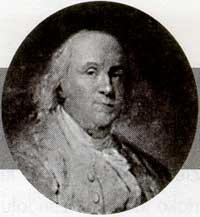Franklin, Benjamin
(1706-1790)
This American scientist and politician was born on January 17, 1706 in Boston, capital of the state of Massachusetts. He was number fifteen of his seventeen brothers and throughout his life he worked in numerous trades, being a writer, printer, politician, diplomat and scientist.

He made a series of inventions in the improvement of bifocal stoves and glasses, but the most important scientific advances introduced them in electricity. Static electricity was a fascinating phenomenon, the XVII. In the 18th century the German physicist Otto von Guericke manufactured the first electric friction machine. In 1745, a special ship was invented at the University of Leyden in Colorado. It was a glass container lined internally with metal and with a metal bar in the center. In the inner metal lining many electric loads generated by the friction machine were collected and if someone touched the central bar, he did not forget for a few days the shock of the discharge. When Leyden's ship was approached by some metal, in addition, a small spark was skipped, bringing a noise to the air.
Many scientists experimented with Leyden's ship, but Franklin came up with a curious idea. He thought that spark and the noise of the air were just lightning and a little thunder. Was the exchange of electric charges between Earth and clouds on a huge Leyden ship not lightning and celestial thunder?
Benjamin Franklin conducted a special essay in 1752, a stormy day. He dropped a kite and held it high in the air with a silk thread. The comet had a tip wire on the top and if there was electricity in the sky, attracted by that wire, the comet would be loaded. At the lower end of the silk thread, the kite had a metal grip and when Franklin approached his hand the spark jumped, as in the Leyden boat.
Franklin's comet surprised people and his essay belonged to the Royal Society. Two other scientists also tried comets during the storm like Franklin, but unfortunately both died iodized. Franklin had a great fortune because he did not know that his performance was so dangerous.
In 1747 Franklin observed that Leyden's ship was unloaded more easily if the sharp piece approached the central bar. It seemed that the tip attracted electric charges. Therefore, by placing pointed bars on the roofs of the houses and connecting them to the ground, electric loads (rays) could be carried to the ground in the clouds without the buildings being at risk.
Franklin obtained good results with "lightning rods" and in 1782 they were installed in the four hundred buildings of Philadelphia.
In Franklin's time they knew there were two types of electricity. Rubbing two bars of amber electrify and repel. The same goes for two glass bars. But the electrified and glass amber bars do not repel, but attract.
Franklin explained this phenomenon by saying that electricity was missing or leftover from a fluid. The piece with excess fluid could attract the missing one and the two electrifications could be neutralized.
Franklin noted that excess fluid should be called positive electricity and lack of negative electricity. Today electricity is expressed by subatomic particles (and especially by electrons) and we know that Franklin's positive electricity is the lack of electrons. The electrician considers that in the circuits the electric current goes from positive to negative terminal, but the physicist knows that the electrons have the reverse path.
Benjamin Franklin also studied American storms. the Gulf hot water stream in the North Atlantic, for example, was the first to study it.
He participated as a politician and diplomat in the creation of the United States. By separating the American colonies from Britain, Franklin contributed to the drafting of the Declaration of Independence. In 1776 he arrived in France as a diplomat to ask for military and financial aid to the colonies.
Benjamin Franklin died in the Philadelphia of Pennsylvania on April 17, 1790.
Buletina
Bidali zure helbide elektronikoa eta jaso asteroko buletina zure sarrera-ontzian











